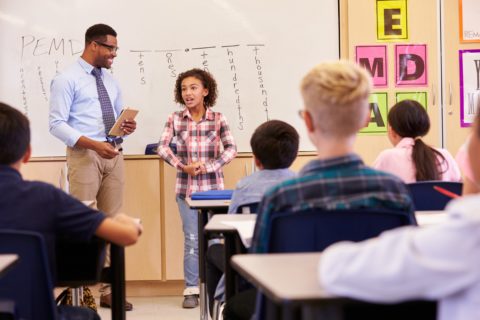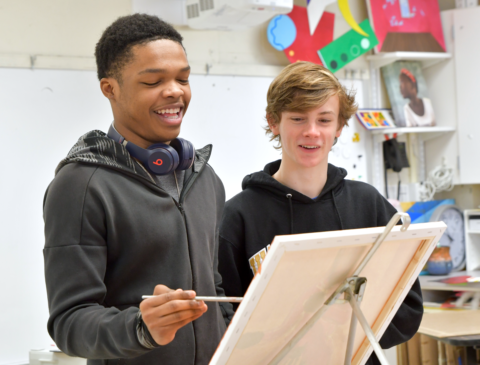By Sung Hee Kim
Earlier this school year, we sat down with Sung Hee Kim, First Grade Teacher and Lower School Diversity, Equity, and Belonging Co-coordinator at St. Andrew’s Episcopal School (MD). Our discussion explored her DEB work and the development of the 4 Guiding Principles Chart – a set of essential questions created to help teachers consciously develop their DEB lenses and effectively interweave belonging with Mind, Brain, and Education Science in early childhood and elementary classrooms.
It all started with a simple question early one spring morning almost two years ago. An Upper School teacher and parent was walking his child to the Lower School building, and we met up on the path. After exchanging pleasantries, my colleague happened to remark, “I am interested to learn how DEB [Diversity, Equity and Belonging] is taught in the Lower School.” It was a valid request as I am one of the Lower School Diversity, Equity and Belonging (DEB) coordinators. However, this exchange sent me into a tailspin. I know that our teachers do an incredible amount of work to advance DEB among our young student body, and that these teachers are also successful at it, but I struggled to find where to begin telling this story. Meanwhile, I saw the distance between us and the front door narrowing, and I knew I could not come up with a twenty-second sound bite that would do our teachers justice before my colleague and I parted ways. What I recall from that moment is not what I said in response, but rather the sinking feeling that I had failed to communicate our teachers’ great work. However, this seminal question is what launched a series of events that eventually led to the creation of the 4 Guiding Principles Chart – a set of organized, essential questions created to help teachers consciously develop their DEB lens and consistently implement their expert knowledge to navigate our daily DEB and Mind, Brain, and Education Science (MBE) classroom demands.
A diversity lesson comes alive and connects with the students when we teachers let our authentic selves shine through because our individual identities and lived experiences allow us to create unique learning environments and experiences for our students. However, this also means that we each have blind spots that are uniquely our own. The 4 Guiding Principles Chart was built on the excellent work of our Lower School teachers and provides a practical DEB resource we can use as a guide to further elevate our DEB practice. The essential questions were created to help us uncover our unique blind spots and approach teaching through a DEB lens with consistency and intentionality. Whether the essential questions on the chart are used by teachers as a spot-check in the moment, to help us navigate challenging conversations, or develop an in-depth project for our students, we are excited and interested to learn about the ways teachers will use it going forward.
Long after parting ways with my colleague at the front door on that morning, I still carried his question with me. The way we approach diversity is not limited to race, gender, or sexuality. It is everything a child in our space could represent because our training and development encourages us to understand the whole person. The fact is, we do so much throughout the day that is DEB work. We do it naturally, organically, in the moment, planned, and intentionally, but also while we are not even cognizant of the work we are doing to advance DEB. From the moment students walk through our door on the first day of school, and every day after, we are working on developing qualities in our students that are desirable, but also creates a foundation upon which topics of diversity can be meaningfully taught.
With the support of our Lower School Co-Heads, Judy Kee and Jordan Love, and Lorraine Martinez Hanley – who was the director of DEB at the time – I asked our homeroom teachers to share with me some examples of their DEB work. It was framed as an optional task, so I was thrilled at the enthusiastic response from our teachers in preschool 1 through fifth grade classes who made time during a very busy spring to share robust examples of their work. This made it possible to share with our parent community how we create a culture of belonging in the Lower School during the Family Heritage Festival and Back-to-School Night over the last two years.
When viewing examples of our Lower School DEB work, four main themes emerged. First, I found that there was an emphasis on teaching empathy throughout all the grades. In preschool I and II, teachers explicitly taught names of emotions such as “happy,” “sad,” “angry,” or “excited” to give the students language to express their feelings. Children were then supported in recognizing these emotions in others through facial expressions and body language and were asked to think of ways of being kind to classmates to create positive emotions. The teaching of empathy continued through the grades by building upon the work of prior grades in developmentally appropriate ways. In pre-k, students were asked to recognize emotions in a peer and then put themselves in the peer’s shoes so they would be willing to make compromises which would lead to conflict resolution. Empathy and reasoning skills were combined for second graders who took turns with the job of Peace Maker, whose role it is to practice empathy but also impartiality, justice, and respect while arbitrating a conflict between students before it is brought to the teachers. In fifth grade, empathy became an essential foundation for understanding the life conditions of another person or group of people as students explored specific topics of equity, religion, feminism, and basic human rights.
Given that all St. Andrew’s teachers receive professional learning in MBE by the Center for Transformative Teaching (CTTL), it was not surprising that growth mindset was taught pervasively throughout our Lower School. In the preschool, where developing a growth mindset is a constant endeavor, teachers were effectively using language to show and remind students of the many things they can do on their own, such as cleaning up after snack, hanging up a backpack or placing their lunch in the fridge. In the elementary grades, students were explicitly taught in detail about neuroplasticity and the functions of the brain. First graders learned to “fail joyfully” by reframing failure as a constructive endeavor providing a roadmap to success. First graders also learned that having a true growth mindset means fully believing that, with effort, all persons or groups of people have the same potential for growth. Students learned to view a growth mindset as a condition for creating belonging and achieving true friendship. Fifth graders put this deep understanding of growth mindset into action as they provided empathetic feedback through dialogue to their peers during advisory meetings. Students aimed to motivate and inspire as they reflected upon and affirmed each other as developing academic leaders and social-emotional learners.

Another theme that emerged was a strong emphasis on positive identity formation. In kindergarten, students studied and celebrated their various identity markers through the creation of their, “Proud to be Me” portfolios. Students shared elements of their family culture through stories of special memories and traditions, and received validation from their peers who found commonalities and differences – all of which were acknowledged as making each student uniquely special. In preschool I, students were taught to identify and speak their feelings, which were acknowledged and affirmed. The acknowledgment that our feelings are an important part of ourselves became the basis for further work in subsequent grades. Second graders ensured peers felt seen and affirmed by the Sunshine Helper, whose job it is to identify and engage students who are feeling sad, lonely, or in need of a friend. In third grade, students were empowered to embrace their emotions as a valued part of their identity by learning how to recognize and understand their emotions and develop strategies to regulate them.
The combination of empathy, growth mindset, and positive identity formation all led to creating a culture of belonging for our students. However, all teachers also made the time and space to create environments of belonging explicitly. First graders explored, compared, and contrasted the concepts of belonging and inclusion, and discussed what each student needed to feel belonging. Third graders had fifteen minutes at the beginning and end of the day to share personal stories and interests with their classmates to foster community. Our fourth graders learned about the diverse cultures that are represented in their classrooms so all students can feel that they belong. Periodically, fourth graders had silent “chalk talks” on butcher paper where the class shared thoughts and opinions in writing on a chosen subject. It provided a safe way to create community, especially for the quieter students who were not always comfortable sharing their thoughts. Fifth graders engaged in team building exercises and reflected upon how their actions affirmed our school’s core values. This exercise was used to scaffold the creation of classroom agreements on how they wanted to live and work together throughout the school year.
These four themes serve as the underpinning of the Lower School teachers’ interactions, routines, and lessons. Moreover, this is essential DEB work because when we instill these values in our young students, we develop students who can listen to one another and think critically about specific topics of diversity as they move into higher grades. Students who demonstrate empathy, have a growth mindset, have formed a positive identity, and feel belonging can receive lessons in diversity with an open mind because they have a desire and are able to see individuals and groups of people other than themselves in their full humanity.
Given the significance of these four themes, when Ms. Martinez Hanley approached me to work with her to create a navigation tool for our faculty to use to support our students using DEB and MBE strategies, it made sense that we would build a set of essential questions around these four organically emerging themes, which are also research-informed areas known to promote improved learning outcomes.
Questions have the power to unlock hidden strength. A well-asked question can help us reflect, and grow, and create positive change. If these essential questions can help a teacher serve even one student so that it creates a positive change in the student’s trajectory, it will make this entire endeavor worth it. Two years ago, I personally experienced how a simple question made me reach inside myself to do better for my colleagues. One day, I will have to share with my colleague how his question started it all.
If you are interested in learning more, please email Sung Hee Kim at info@thecttl.org.




